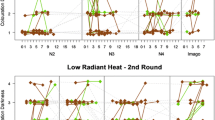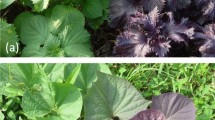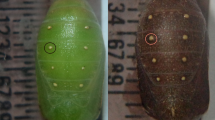Summary
Green larvae of the butterflyPieris rapae and black larvae of the sawflyAthalia rosae feed on green leaves of the same cruciferous plants. To demonstrate thatP. rapae has concealing coloration and thatA. rosae has warning coloration, the larvae of the two species were supplied to naive chicksGallus gallus on white, green or black backgrounds.P. rapae larvae were palatable and their green body color acted as a concealing coloration. On the other hand,A. rosae larvae were unpalatable and their black body color acted as a warning coloration.
There is a general consensus that warning coloration is an altruistic character which needs victims, and thus can evolve through kin selection or green beard selection. However, blackA. rosae larvae were seldom injured by chicks' attack, in particular, on the green background. Therefore, the warning coloration ofA. rosae larvae can be a selfish character and hence can evolve through individual selection as well as concealing coloration ofP. rapae.
Similar content being viewed by others
References
Baker, R. R. (1970) Bird predation as a selective pressure on the immature stages of the cabbage butterflies,Pieris rapae andP. brassicae.J. Zool., Lond.162: 43–59.
Dawkins, R. (1976)The selfish gene. W. H. Freeman, Oxford.
Endler, J. A. (1991) Interaction between predators and prey. 169–196. In J. R. Krebs and N. B. Davies (ed.),Behavioural Ecology: An Evolutionary Approach. Blackwell, Oxford.
Erichsen, J. T., J. R. Krebs and A. I. Houston (1980) Optimal foraging and cryptic prey.J. Anim. Ecol. 49: 271–276.
Fisher, R. A. (1958)The genetical theory of natural selection, 2nd ed. Dover, New York.
Guilford, T. (1985) Is kin selection involved in the evolution of warning coloration?Oikos 45: 31–36.
Guilford, T. (1988) The evolution of conspicuous coloration.Am. Nat. 131:s7-s21.
Gittleman, J. L. and P. H. Harvey (1980) Why are distasteful prey not cryptic?Nature 286: 149–150.
Harvey, P. H. and R. L. Greenwood (1978) Anti-predator defense strategies: some evolutionary problems. 129–151. In J. R. Krebs and N. B. Davies (ed.)Behavioural Ecology. Blackwell, Oxford.
Harvey, P. H. and R. L. Paxton (1981) The evolution of aposematic coloration.Oikos 37: 391–396.
Harvey, P. H., J. J. Bull and R. J. Paxton (1983) Looks pretty nasty.New Sci. 97: 26–27.
Järvi, T., B. Sillén-Tullberg and C. Wiklund (1981a) The cost of being aposematic. An experimental study of predation on larvae ofPapilio machaon by the great titParus major Oikos 36: 267–272.
Järvi, T., B. Sillén-Tullberg and C. Wiklund (1981b) Individual versus kin selection for aposematic coloration: a reply to Harvey and Paxton.Oikos 37: 393–395.
Krebs, J. R. and N. B. Davies (1987)An Introduction to Behavioural Ecology. (2nd ed.) Blackwell, Oxford.
Pietrewicz, A. T. and A. C. Kamil (1981) Search images and the detection of cryptic prey: an operant approach. 311–332. In A. C. Kamil and T. D. Dargent (ed.).Foraging Behavior: Ecological, Ethological and Psychological Approaches. Garland STPM press, New York.
Ridley, M. and A. Grafen (1981) Are green beard outlaws?Anim. Behav. 29: 954–955.
Sillén-Tullberg, B. (1985) Higher survival of an aposematic than of a cryptic form of a distasteful bug.Oecologia 67: 411–415.
Sillén-Tullberg, B. (1988) Evolution of gregariousness in aposematic butterfly larvae: a phylogenetic analysis.Evolution 42: 293–305.
Wiklund, C. and T. Järvi (1982) Survival of distasteful insects after attacked by a native birds: a reappraisal of the theory of aposematic coloration through individual selection.Evolution 36: 998–1002.
Author information
Authors and Affiliations
Rights and permissions
About this article
Cite this article
Ohara, Y., Nagasaka, K. & Ohsaki, N. Warning coloration in sawflyAthalia rosae larva and concealing coloration in butterflyPieris rapae larva feeding on similar plants evolved through individual selection. Res Popul Ecol 35, 223–230 (1993). https://doi.org/10.1007/BF02513594
Issue Date:
DOI: https://doi.org/10.1007/BF02513594




